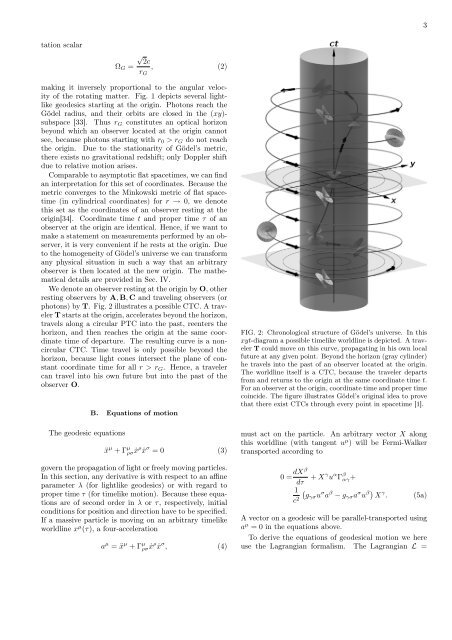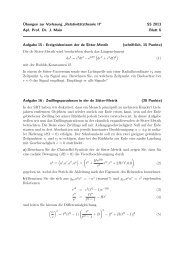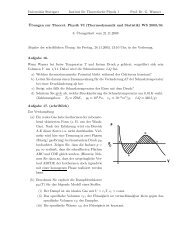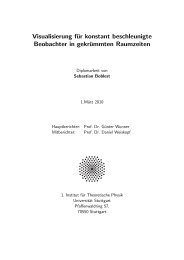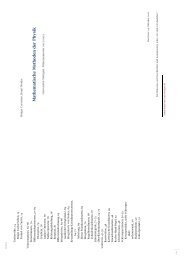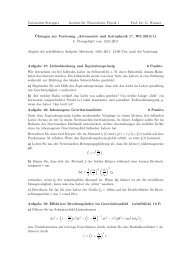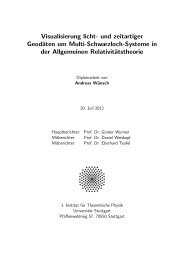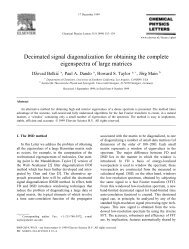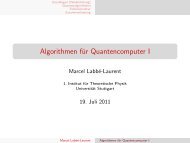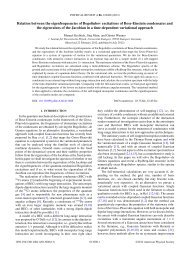The Gödel universe - Institut für Theoretische Physik der Universität ...
The Gödel universe - Institut für Theoretische Physik der Universität ...
The Gödel universe - Institut für Theoretische Physik der Universität ...
You also want an ePaper? Increase the reach of your titles
YUMPU automatically turns print PDFs into web optimized ePapers that Google loves.
tation scalar<br />
ΩG =<br />
√<br />
2c<br />
, (2)<br />
making it inversely proportional to the angular velocity<br />
of the rotating matter. Fig. 1 depicts several lightlike<br />
geodesics starting at the origin. Photons reach the<br />
<strong>Gödel</strong> radius, and their orbits are closed in the (xy)subspace<br />
[33]. Thus rG constitutes an optical horizon<br />
beyond which an observer located at the origin cannot<br />
see, because photons starting with r0 > rG do not reach<br />
the origin. Due to the stationarity of <strong>Gödel</strong>’s metric,<br />
there exists no gravitational redshift; only Doppler shift<br />
due to relative motion arises.<br />
Comparable to asymptotic flat spacetimes, we can find<br />
an interpretation for this set of coordinates. Because the<br />
metric converges to the Minkowski metric of flat spacetime<br />
(in cylindrical coordinates) for r → 0, we denote<br />
this set as the coordinates of an observer resting at the<br />
origin[34]. Coordinate time t and proper time τ of an<br />
observer at the origin are identical. Hence, if we want to<br />
make a statement on measurements performed by an observer,<br />
it is very convenient if he rests at the origin. Due<br />
to the homogeneity of <strong>Gödel</strong>’s <strong>universe</strong> we can transform<br />
any physical situation in such a way that an arbitrary<br />
observer is then located at the new origin. <strong>The</strong> mathematical<br />
details are provided in Sec. IV.<br />
We denote an observer resting at the origin by O, other<br />
resting observers by A,B,C and traveling observers (or<br />
photons) by T. Fig. 2 illustrates a possible CTC. A traveler<br />
T starts at the origin, accelerates beyond the horizon,<br />
travels along a circular PTC into the past, reenters the<br />
horizon, and then reaches the origin at the same coordinate<br />
time of departure. <strong>The</strong> resulting curve is a noncircular<br />
CTC. Time travel is only possible beyond the<br />
horizon, because light cones intersect the plane of constant<br />
coordinate time for all r > rG. Hence, a traveler<br />
can travel into his own future but into the past of the<br />
observer O.<br />
<strong>The</strong> geodesic equations<br />
rG<br />
B. Equations of motion<br />
¨x µ + Γ µ ρσ ˙x ρ ˙x σ = 0 (3)<br />
govern the propagation of light or freely moving particles.<br />
In this section, any <strong>der</strong>ivative is with respect to an affine<br />
parameter λ (for lightlike geodesics) or with regard to<br />
proper time τ (for timelike motion). Because these equations<br />
are of second or<strong>der</strong> in λ or τ, respectively, initial<br />
conditions for position and direction have to be specified.<br />
If a massive particle is moving on an arbitrary timelike<br />
worldline x µ (τ), a four-acceleration<br />
a µ = ¨x µ + Γ µ ρσ ˙x ρ ˙x σ , (4)<br />
FIG. 2: Chronological structure of <strong>Gödel</strong>’s <strong>universe</strong>. In this<br />
xyt-diagram a possible timelike worldline is depicted. A traveler<br />
T could move on this curve, propagating in his own local<br />
future at any given point. Beyond the horizon (gray cylin<strong>der</strong>)<br />
he travels into the past of an observer located at the origin.<br />
<strong>The</strong> worldline itself is a CTC, because the traveler departs<br />
from and returns to the origin at the same coordinate time t.<br />
For an observer at the origin, coordinate time and proper time<br />
coincide. <strong>The</strong> figure illustrates <strong>Gödel</strong>’s original idea to prove<br />
that there exist CTCs through every point in spacetime [1].<br />
must act on the particle. An arbitrary vector X along<br />
this worldline (with tangent u µ ) will be Fermi-Walker<br />
transported according to<br />
0 = dXβ<br />
1<br />
c 2<br />
dτ + Xγ u α Γ β αγ+<br />
gγσu σ a β − gγσa σ u β X γ . (5a)<br />
A vector on a geodesic will be parallel-transported using<br />
a µ = 0 in the equations above.<br />
To <strong>der</strong>ive the equations of geodesical motion we here<br />
use the Lagrangian formalism. <strong>The</strong> Lagrangian L =<br />
3


